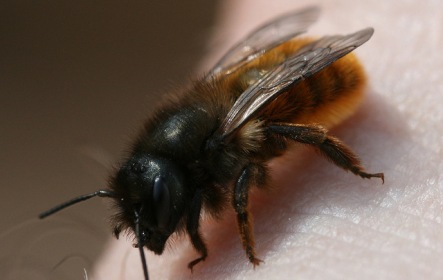You might have heard – bees and other pollinators are in trouble!
Here is One solution to all the foods that depend on honey-bees for pollination
A recent federal survey indicated another heavy bee die-off this winter, while another study shows honeybees’ pollen and hives laden with pesticides. Another concern – “colony collapse disorder” – was blamed for large, inexplicable die-offs. This disorder causes adult bees to abandon their hives and fly off to die. The cause – probably a result of many things and likely a combination parasites, viruses, bacteria, poor nutrition and pesticides. In fact, every year more than one-third of the commercial colonies die—some because of Colony Collapse Disorder (CCD), and some to other causes. Things just seem to be getting worse.
What does it all mean? For sure it means bad news for farmers BUT also bad news for the rest of us. Don’t forget pollinators are directly responsible for most of the food we eat.
Have you ever considered keeping Mason Bees?
• Mason Bees are found throughout North America in the early Spring and summer. They are “solitary”, which means that each female nests without the cooperation of other female bees. The female chooses and provisions a nest, and produces the young by herself.
• Mason Bees are expert pollinators! They are one of the earliest pollinators available and for most plants Mason Bees are far more effective than Honey Bees. They are not as susceptible to the viruses and molds that attack Honey Bees, and by encouraging our native species you are helping to restore the balance of nature.
The Best about Mason Bees…
• Low maintenance – you don’t really have to “keep” Mason Bees. They mostly take care of themselves.
• They Don’t Sting! (Well hardly ever…) Mason Bees are non-aggressive and do not tend to sting at all.
• Expert Pollinators – in fact much more efficient than Honey Bees! (Forty Mason bees are about the same as having as 3 or 4 hives – or several thousand European Honey Bees)
Why Doesn’t Everybody Keep Them?
• Simply – they do not make honey, and “No Honey = No Money”.
Life Cycle
• Early Spring…Adult Bees break through mud walls and emerge from their over-wintering nests. Males arrive first, and then wait for the females so that mating can begin.
• Late Spring…Females lay eggs in nesting holes along with pollen for each egg.
• Summer…The bees that emerged in early Spring have died. Larvae develop into pupae and then cocoons within the nesting holes.
• Winter…During winter inside their cocoons – the new bees get ready for early Spring when the cycle begins again.
Housing – If you build it – they will come!
• Mason Bee houses come in all shapes and sizes, often similar to bird houses.
• Essentially they are tunnels or tubes where the females can make their nests. These tunnels can be made of wood, cardboard or in the wild bees tunnel into clay cliffs or take advantage of tunnels in trees. Nests are usually east facing so the sun can warm them.
• It is important that their nests be protected from predators such as woodpeckers and weather.
If you want to give your garden or trees a better chance – don’t leave pollination to chance. With little or no start up cost, upkeep or effort, mason bees are an easy addition to your urban farming efforts with big pollination rewards!
For more information on Mason Bees and other pollinators contact:
Butterfly Wings n’ Wishes Ltd.
Edmonton AB T6L 1A3
Phone: 780-462-1839
ButterflyWingsnWishes


